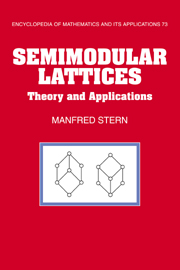Book contents
- Frontmatter
- Contents
- Preface
- 1 From Boolean Algebras to Semimodular Lattices
- 2 M-Symmetric Lattices
- 3 Conditions Related to Semimodularity, 0-Conditions, and Disjointness Properties
- 4 Supersolvable and Admissible Lattices; Consistent and Strong Lattices
- 5 The Covering Graph
- 6 Semimodular Lattices of Finite Length
- 7 Local Distributive
- 8 Local Modularity
- 9 Congruence Semimodularity
- Master Reference List
- Table of Notation
- Index
9 - Congruence Semimodularity
Published online by Cambridge University Press: 05 May 2010
- Frontmatter
- Contents
- Preface
- 1 From Boolean Algebras to Semimodular Lattices
- 2 M-Symmetric Lattices
- 3 Conditions Related to Semimodularity, 0-Conditions, and Disjointness Properties
- 4 Supersolvable and Admissible Lattices; Consistent and Strong Lattices
- 5 The Covering Graph
- 6 Semimodular Lattices of Finite Length
- 7 Local Distributive
- 8 Local Modularity
- 9 Congruence Semimodularity
- Master Reference List
- Table of Notation
- Index
Summary
Semilattices
Summary. Algebras whose congruence lattices satisfy nontrivial lattice identities have been thoroughly studied during the last two decades. In particular, varieties have been investigated in which the congruence lattice of all algebras is distributive or modular. Although weaker than modularity, semimodularity is still an interesting property in this connection. Ore [1942] proved that sets have semimodular congruence lattices (in fact, these are matroid lattices). Here we describe some properties of congruence lattices of semilattices that were shown to be semimodular by Hall [1971].
An algebra S = (S: ·) with a binary operation · is called a semigroup if this operation is associative, that is, x · (y · z) = (x · y) · z holds for all x, y, z ∈ S. For simplification we briefly write ab for a · b. We shall identify S with S if there is no danger of confusion. A semilattice is a semigroup satisfying xy = yx (commutativity) and x2 = x (idempotency) for all x, y ∈ S. We may impose a partial order on S by defining x ≤ y if xy = x. Under this ordering, any two elements x, y ∈ S have a greatest lower bound, namely their product xy. Hence S is a (meet) semilattice.
An algebra A is said to be locally finite if every subalgebra of A generated by finitely many elements is finite. A variety ∨ is said to be locally finite if every algebra in ∨ is locally finite, or equivalently, every finitely generated algebra in ∨ is finite. Semilattices form a locally finite variety. We denote this variety by Semilattices.
Information
- Type
- Chapter
- Information
- Semimodular LatticesTheory and Applications, pp. 312 - 335Publisher: Cambridge University PressPrint publication year: 1999
